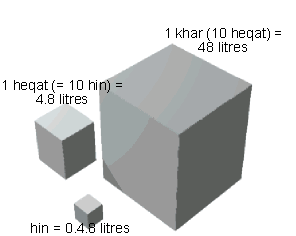
Measuring volume in Ancient Egypt
Most often written sources refer to units for
measuring grain: in the New Kingdom (about 1550-1069 BC) there are capacity
measures for other materials such as honey, resin and gold-dust
Three main measures are ‘jar’ (Egyptian hnw, in
Egyptology cited as hin), ‘barrel’ (HqAt vocalised in Egyptology as heqat) and
‘sack’ (XAr vocalised in Egyptology as khar)
Old and Middle Kingdom (about 2025-1700 BC): 1 khar = 10 heqat, 1 heqat
= 10 hin
Jars inscribed with hin-measurements indicate
that 1 hin corresponds to 0.48 litres (earlier calculations gave about 0.503
litres)
Therefore 1 heqat would be about 4.8 litres, and
1 khar about 48 litres.

Middle Kingdom accounts refer to single and double
heqat measures
Late New Kingdom sources indicate that official
usage preferred the quadruple heqat, named ipt (in Egyptology cited as oipe),
and four of these (sixteen single heqat) now corresponded to one khar (‘sack’)
Beside the predominant official systems, other
measuring units evidently existed, even in the official domain: the decree of
Horemheb (about 1300 BC) refers to
a ‘house-ipt’ corresponding to 5 heqat=50 hin
Copyright © 2002 University College London. All rights reserved.